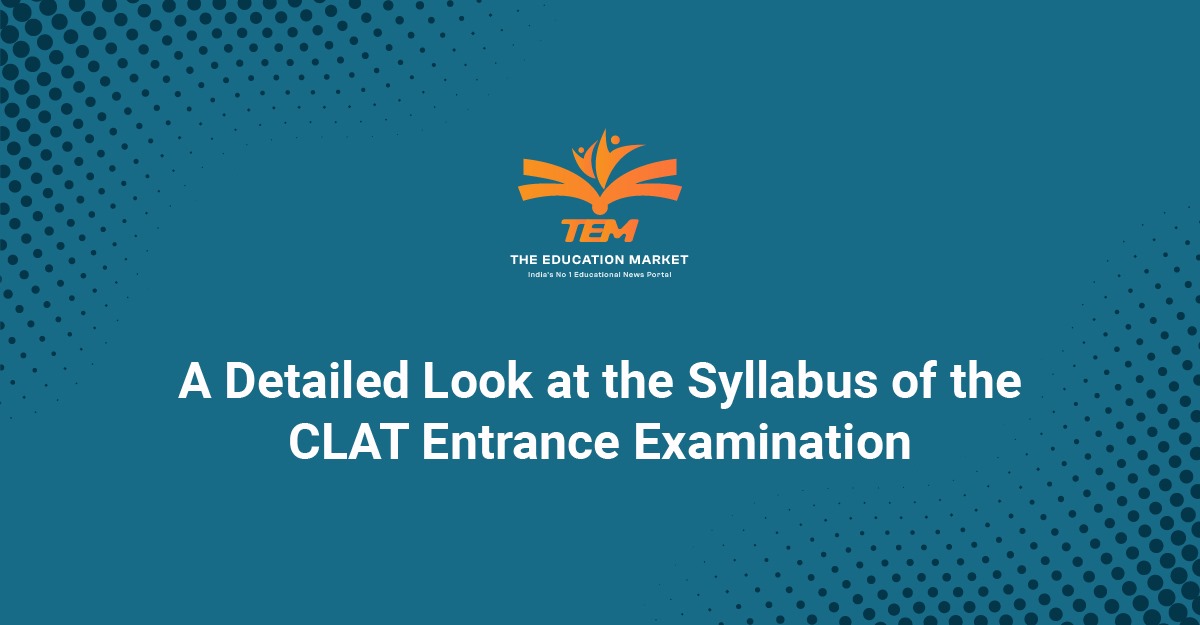Are you interested in building a successful career in the field of law? Then, you will have to pursue your legal education at one of the top National Law Universities in the country. To do this, you need to appear for the Common Law Admission Test. The first step in this journey is understanding the CLAT exam syllabus. In this comprehensive blog, we will have a Detailed Look at the Syllabus of the CLAT. We will also understand the weightage of each section and check which are the best colleges where you can pursue your degree-level education. Want to know this and much more about the CLAT entrance examination?
Section-Wise Weightage for the CLAT Entrance Examination
In the table below, we have mentioned the different sections of the CLAT entrance examination. We have also mentioned the approximate number of questions that will be asked and the weightage that each section carries.
| Section Name | Number of Questions in the Section | Weightage (in %) |
| English Language | 22 to 26 Questions | 18.66 – 21.33 |
| Current Affairs, including General Knowledge | 28 to 32 Questions | 23.33 – 26 |
| Quantitative Techniques | 10 to 14 Questions | 8.66 – 11.33 |
| Legal Reasoning | 28 to 32 Questions | 23.33 – 26 |
| Logical Reasoning | 22 to 26 Questions | 18.66 – 21.33 |
When preparing for the CLAT entrance examination, you must be aware of these sections and their weightage. This will help you understand what section you must prioritize and focus more on.
Syllabus Included in the Different Sections of the CLAT Exam
Now that you have understood the section-wise weightage let us walk you through the CLAT syllabus included in each section.
Also Read: Knowledge Nation Law Center
English Language Syllabus for the CLAT Exam
Listed below are the topics you will need to cover in order to solve the English questions in the examination:
- Active & passive voice
- Analytical skills
- Correcting incorrect grammar sentences
- Fast reading and comprehension
- Fill in the Blanks
- Grammar and vocabulary
- Spotting grammatical errors
- Synonyms & antonyms
- Tenses
Current Affairs Syllabus for the CLAT Exam (including General Knowledge)
For the current affairs and general knowledge section from the syllabus of CLAT exam, below are the key topics that you will have to cover:
- Arts & Culture
- Awards & Honours
- Contemporary events of significance from India and the world
- Historical events of continuing significance
- Important Historical Events
- International affairs
- National & International Affairs
- Schemes
- Science & Technology
- Sports
- Summits & Conferences
Also Read: 7 Best CLAT Coaching Institutes in Delhi (Rank wise)
Quantitative Techniques Syllabus for the CLAT Exam
Here’s what you will have to study in order to clear the quantitative techniques section of this entrance examination. This is the section with the minimum weightage as well.
- Algebra
- Basic algebra
- Mensuration
- Ratios and proportions
- Statistical estimation
Legal Reasoning Syllabus for the CLAT Exam
The legal reasoning syllabus of CLAT entrance test includes the following:
- Bigamy and Constitution Void and Voidable Marriage
- Contract Act
- Contract Law
- Indian Penal Code (IPC) and related concepts
- Juvenile Justice Act
- Law of Torts
- Law of writs
- Monism and Dualism
- Penal law
- Personal data protection bill
- Personal laws — Special Marriage Act
- Public international law
Also Read: All about DU.LLB / CUET PG Law Exam (Fees, Contacts & Reviews)
Logical Reasoning Syllabus for the CLAT Exam
The logical reasoning section of the CLAT examination includes the following topics:
- Analogies
- Blood relations
- Calendars and clocks
- Logical sequences and matching
- Seating arrangement
- Series
- Syllogisms
Colleges Where the Score of the CLAT Examination is Accepted
There are many excellent National Law Universities or NLUs in the country. Each of these follows a standard and effective curriculum and ensures that students get the highest quality of education. Getting admission to one of these institutions is one of the biggest dreams in the lives of many students. Want to know more about these universities? Then, refer to the list below:
Detailed Information about NLUS
| Name of the College | Number of Seats Available |
| Chanakya National Law University (CNLU), Patna | 69 seats |
| Damodaram Sanjivayya National Law University (DSNLU), Visakhapatnam | 60 seats |
| Dharmashastra National Law University (DNLU), Jabalpur | 57 seats |
| Dr B R Ambedkar National Law University (DBRANLU), Sonipat, Haryana | – |
| Dr Ram Manohar Lohiya National Law University (RMLNLU), Lucknow | 24 seats |
| Gujarat National Law University (GNLU), Gandhinagar | 58 seats |
| Hidayatullah National Law University (HNLU), Raipur | 60 seats |
| Himachal Pradesh National Law University (HPNLU), Shimla | 40 seats |
| Maharashtra National Law University (MNLU), Mumbai | 50 seats |
| Maharashtra National Law University, Aurangabad | 60 seats |
| Maharashtra National Law University, Nagpur | 20 seats |
| National Academy of Legal Study & Research (NALSAR) University of Law, Hyderabad | 60 seats |
| National Law Institute University (NLIU), Bhopal | 60 seats |
| National Law School of India University (NLSIU), Bengaluru | 50 seats |
| National Law University & Judicial Academy (NLUJA), Assam | 30 seats |
| National Law University Odisha (NLUO), Cuttack | 46 seats |
| National Law University, Jodhpur | 50 seats |
| National University of Advanced Legal Studies (NUALS), Kochi | 60 seats |
| National University of Study & Research in Law (NUSRL), Ranchi | 50 seats |
| Rajiv Gandhi National University of Law (RGNLU), Patiala | 58 seats |
| The Tamil Nadu National Law University (TNNLU), Tiruchirapalli | 18 seats |
| The West Bengal National University of Juridical Sciences (WBNUJS), Kolkata | 60 seats |
In addition to these, there are many private colleges in the country to which you will be able to apply for a degree after clearing the CLAT entrance exam. The cutoff score varies from year to year, and the number of seats available in each of these colleges is also variable. Hence, you need to conduct thorough research about these colleges, their eligibility criteria, and their fee structure before making a choice.
Also Read: How to Prepare for the AILET exam?
Courses Offered Under the CLAT Exam at the Top NLUs
There are multiple courses that you will be able to pursue after you have understood the CLAT syllabus and cleared the exam. These include the following:
- Master of Law
- Bachelor of Arts+ Bachelor of Law (BA LLB)
- Bachelor of Business Administration + Bachelor of Law (BBA LLB)
- Bachelor of Commerce + Bachelor of Law (BCom LLB)
- Bachelor of Science + Bachelor of Law (BSc LLB)
- Bachelor of Technology + Bachelor of Law (BTech LLB)
To pursue the Master of Law course, you have to crack the CLAT PG entrance examination. The total duration of this postgraduate-level course is 3 years. For the other courses mentioned in the list above, the aspirant needs to clear the CLAT UG exam with cutoff marks. These are degree programs with a minimum tenure of 5 years.
Also Read: Complete DU LLB Syllabus: Your Ultimate Guide to Start DU.LLB Preparation
Frequently Asked Questions
How long will it take to study the entire CLAT syllabus?
In order to cover the complete CLAT entrance syllabus, you will have to study consistently for 6 to 8 hours every day for a tenure of 6 to 8 months.
Can I download the CLAT study material online?
Yes, you can download the syllabus as well as the study notes for studying for the CLAT examination online. Of course, when doing this, you need to make sure that you are doing it from the most reliable resources.
Does the CLAT exam syllabus change every year?
Some aspects of the CLAT entrance examination keep changing from time to time. However, the core sections of the syllabus remain constant.
Do all sections in the CLAT syllabus carry equal weightage?
No. The different sections included in the CLAT syllabus have varied weightage. While Quantitative Techniques has only 10 to 14 questions, both the Current Affairs, including General Knowledge and Legal Reasoning sections, have 28 to 32 questions each.
Also Read: Best YouTube channels for CLAT preparation
Is coaching necessary to prepare for the CLAT entrance examination?
Usually, the answer to this question depends on the preferences of the student. While some students want to study solely without any interaction and disturbance, others want a competitive environment where they can ask multiple questions. For aspirants with the former case, preparation without coaching is easily possible. On the contrary, those with the latter case will need assistance from a coaching institute.
Should I appear for the CLAT exam if I want admission to NLU Delhi?
No. For students who wish to pursue their education at the National Law University of Delhi, CLAT is not the applicable exam. These aspirants need to appear for the AILET exam or the All India Law Entrance Test.
Related Article: Is coaching necessary to crack the DU.LLB. / CUET PG exam? , How to Prepare for the DU.LLB Exam? (Expert Tips and Tricks) , 7 Best DU.LLB Coaching Institutes in Delhi (Rank wise), 7 Best CLAT Coaching Institutes in India (Rank wise), Complete DU LLB Syllabus: Your Ultimate Guide, Syllabus of CLAT Entrance Examination: Detailed Overview & Analysis, How To Become a Judge? (Must Read)

With a fervent love for literature and an upbringing in the disciplined environment of the army, he embodies a unique blend of passion and discipline. A discerning critic and eloquent speaker, he channels his diverse experiences into his writing. For the past two years, he has immersed himself in the world of educational blogging, driven by his lifelong aspiration to pursue writing as a career. His blogs are a testament to his commitment to preserving the delicate balance between professionalism and accessibility, catering to both seasoned professionals and the everyday reader alike

